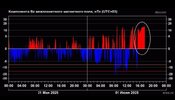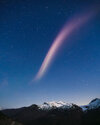ALERT: A medium-strength magnetic storm is occurring with the possibility of reaching strong levels
On Earth, starting from 11 p.m. Moscow time,
a magnetic storm has been registered and as of 4 a.m. has not stopped, having reached the G2.3 level at the moment. The event duration is currently about 5 hours. The G2.3 event score is above the average level and exceeds the threshold, starting from which the impact on energy systems and the propagation of radio waves becomes noticeable. The causes of the storm are not obvious at the moment. In the last hours, measuring instruments showed a noticeable increase in plasma density and magnetic field induction in the solar wind surrounding the Earth. At the same time, the plasma velocity (the main indicator of the arrival of mass ejections or matter flow from the coronal hole to the Earth) has not increased. The event was also absent from the geomagnetic forecast.
The impact of a large coronal hole on the Earth, which is already clearly visible in the southern hemisphere of the Sun , was predicted for the next 24 hours (the night of June 13-14). This allows us to assume that the Earth is currently interacting with a dense flow of matter formed at the edge of the coronal hole. Inside coronal holes, the plasma is, as expected, very rarefied, which is sometimes compensated by a density jump at their boundaries. If this is so, then the speed of the solar wind, which is still unchanged, may begin to grow earlier than scheduled, already today, June 13, during the day.
The duration and possible strength of the current storm are difficult to predict: the event, as already noted, was not in the forecast, and, in addition, we are talking about transient boundary processes that are difficult to evaluate mathematically. For now, we can only state that the planet is prematurely entering a 2-3 day period of complex geomagnetic conditions with strong fluctuations in geomagnetic indices. The last time this hole passed in front of the Earth, in May 2025, the peak values of the magnetic storms recorded then were in the G2-G3 range.



 community.spaceweatherlive.com
community.spaceweatherlive.com









